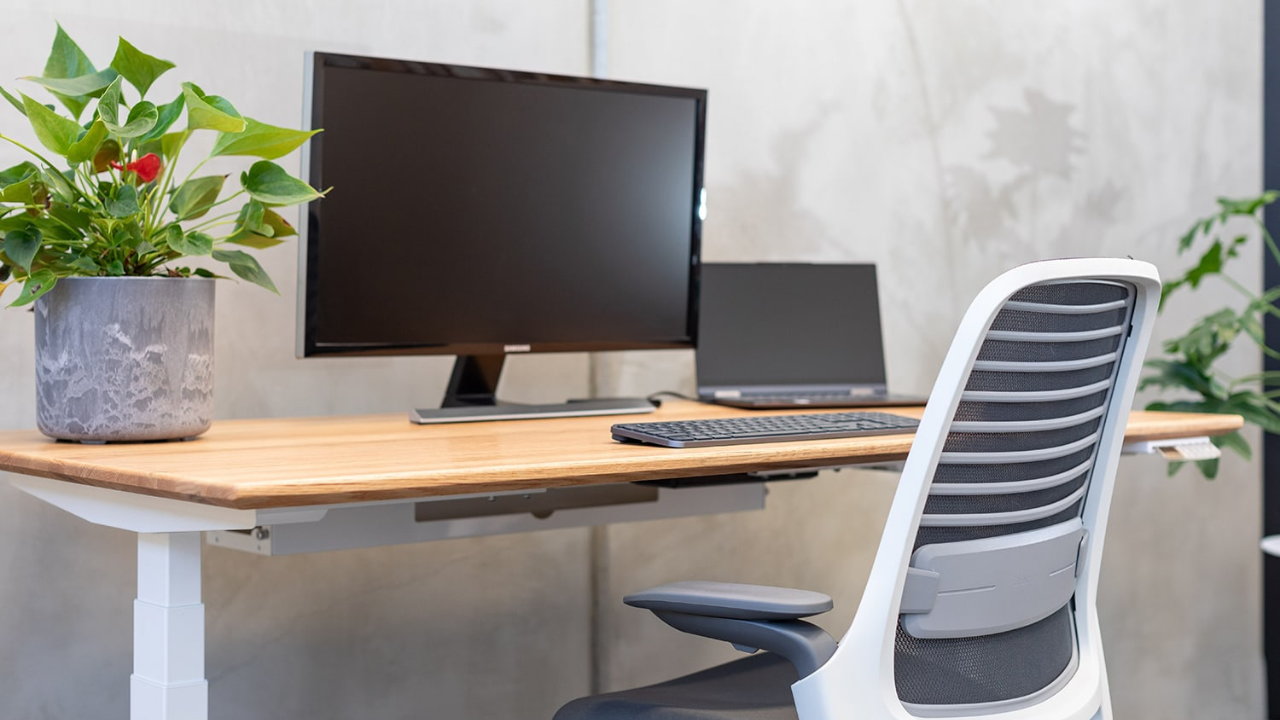Standing desks have surged in popularity, and it’s only fitting to address how to use them properly. While they promise many health benefits, they aren’t any different when used the same way as sitting desks.
In this article, I discuss the pros and cons of wearing shoes at a standing desk, the benefits and risks of standing barefoot, and expert opinions on the best practices for maintaining foot health.
Wearing Shoes at a Standing Desk
One crucial aspect of using a sit-stand desk is your choice of footwear. Unlike sitting, your legs support your entire body weight when standing. So, the right shoes significantly matter.
Good shoes offer support and stability, reducing the risk of slipping or losing balance when working. They help prevent common injuries from prolonged standing, such as plantar fasciitis and Achilles tendinitis.
Similarly, shoes with adequate cushioning minimise foot fatigue so you can stand for extended periods without discomfort. But depending on your choice of footwear, you can suffer from foot fatigue or become overly reliant on shoes that you’re uncomfortable without them when not standing.
Standing Barefoot at a Standing Desk
The alternative is the barefoot approach. If you work with an anti-fatigue mat, I recommend trying this first. Standing barefoot lets your feet maintain a natural position, improving posture and alignment.
That aside:
- Being barefoot provides a direct connection to the ground or floor, which enhances your balance and stability.
- Going without shoes also helps strengthen the muscles in your feet and lower legs, promoting overall foot health.
The downsides are the lack of arch support in footwear, the potential for injury on hard or rough surfaces, and hygiene concerns. If you work in a corporate office, this also paints a negative picture of yourself and the office.
Basics of Using a Standing Desk

As I mentioned, using a standing desk requires good practices and habits to make the most of them. Here are three things to keep in mind:
#1 - Ensure proper desk setup
Start by adjusting your desk to the correct height, i.e., high enough so that your elbows are at a 90-degree angle when typing, your wrists are straight, and your hands hover comfortably over the keyboard.
Next, position your monitor so the top of the screen is at or slightly below eye level. Ideally, the monitor should be about 50 cm (or an arm's length) away from your face. If your desk setup includes a laptop, use a laptop stand and an external keyboard and mouse for better ergonomics.
Finally, ensure that your accessories are close enough to avoid overreaching, which often strains your shoulders and arms.

#2 - Practice good posture
Stand with your feet shoulder-width apart, and distribute your weight evenly on both feet. Avoid leaning on one leg or shifting your weight unevenly to prevent muscle imbalances and discomfort. I also recommend keeping your knees slightly bent to avoid locking them.
Additionally, it's essential that your head is aligned with your spine; avoid leaning forward or tilting your head up or down excessively. Practising these standing posture habits reduced the risk of common musculoskeletal issues associated with prolonged standing.
#3 - Alternate frequently
Most experts recommend the 20-8-2 rule: spend 20 minutes sitting, 8 minutes standing, and 2 minutes moving around to balance the load on your muscles and joints and reduce the risk of fatigue and discomfort.
If you are new to using a standing desk, the appropriate thing to do is to build up your standing time gradually. Start with short intervals of standing and increase the duration as your body adapts. Here, you do not have to follow any rules; you just have to listen to your body.
How to Choose the Right Footwear?

To choose the appropriate footwear for your sit-stand desk, look for shoes with good arch support and cushioning. Athletic or orthopaedic footwear are good choices as they’re designed to provide stability and comfort during prolonged periods of standing.
Similarly, consider the type of flooring in your workspace; if it's a hard floor, shoes with extra padding or an anti-fatigue mat to reduce strain on your feet and legs will be beneficial. Ensure they fit well, with enough room for your toes to move comfortably but not so loose that your feet slide around.
Conclusion
To decide between wearing shoes or going barefoot, you must weigh the advantages and disadvantages of both options. Here’s a summary of everything we’ve discussed so far:
Wearing shoes
- Pros: Increased support, reduced injury risk, and enhanced comfort.
- Cons: Potential for over-reliance on shoes and possible foot fatigue from certain types of footwear.
Going barefoot
- Pros: Natural positioning, muscle strengthening, and better ground connection.
- Cons: Lack of arch support, the potential for injury on hard or rough surfaces, hygiene concerns, and corporate culture limitations.
The best approach depends on your preferences. Try either option for short periods to find which best suits you; it improves your productivity and general well-being. You're also not bound to a single approach; alternate between footwear and going barefoot if it's helpful.








